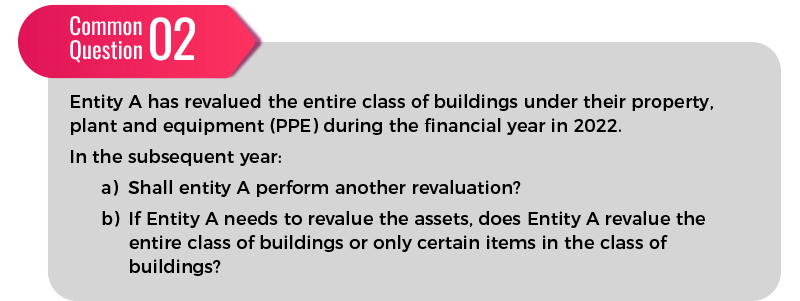By the MIA Sustainability, Digital Economy, and Reporting Team
MIA has received various accounting queries on investment property and property, plant and equipment (PPE) through our technical queries facility. In this article, we will be sharing a few common questions received and the suggested guidance for reference. In June 2022, we issued an article on common issues on consolidation. You may view the article here.
Land and building

MFRS
Paragraph 58 of MFRS 116 Property, Plant and Equipment requires land and buildings to be accounted as separable assets even when they are acquired together. The requirement facilitates in determining the depreciation amount and depreciation period of an asset. Land usually has an unlimited useful life and therefore is not depreciated, while buildings have a limited useful life and therefore are depreciable assets. Paragraph 59 of MFRS 116 further states that “if the cost of land includes the costs of site dismantlement, removal, and restoration, that portion of the land asset is depreciated over the period of benefits obtained by incurring those costs”. If land is purchased together with buildings, it is necessary to allocate the purchase consideration between the value of the land and that of the buildings.¹
As stated in paragraph 27 of MFRS 13 Fair Value Measurement, fair value measurement of a non-financial asset takes into account a market participant’s ability to generate economic benefits by using the asset in its highest and best use or by selling it to another market participant that would use the asset in its highest and best use. The highest and best use takes into account the use of the asset that is physically possible, legally permissible and financially feasible as stated in paragraph 28 of MFRS 13.²
Thus, in order to account for the land and building separately, entity A will need to value the land and building based on the requirements of MFRS 13.
MPERS
Similar to MFRS, paragraph 17.8 of MPERS Section 17 Property, Plant and Equipment also requires that land and buildings be accounted for separately (even when they are acquired together), as they are separable assets. This is intended to facilitate component depreciation and to ensure that when assessing residual value, an increase in land value does not mask the need to depreciate the building’s element of the land and building.³
Frequency of revaluations

MFRS
- Paragraph 34 of MFRS 116 highlights that some items of PPE experience significant and volatile changes in fair value which necessitate annual revaluation. Such frequent revaluations are unnecessary for items of PPE with only insignificant changes in fair value and thus it may be necessary to revalue the item every three or five years.
- Paragraph 36 of MFRS 116 further requires that revaluation will need to be performed on the entire class of PPE to which that asset belongs (i.e., buildings). This is to avoid selective revaluation of assets and the reporting of amounts in the financial statements that are a mixture of costs and values as at different dates.
MPERS
Paragraph 17.15B of MPERS Section 17 states that “revaluations shall be made with sufficient regularity to ensure that the carrying amount does not differ materially from that which would be determined using fair value at the end of the reporting period”. It further states that “if an item of PPE is revalued, the entire class of PPE to which that asset belongs shall be revalued”.
Net book value

MFRS and MPERS
Paragraph 67 of MFRS 116 requires that the carrying amount of an item of PPE shall be derecognized upon disposal or when no future economic benefits are expected from its use or disposal. Paragraph 17.27 of MPERS Section 17 has similar requirements.
Accordingly, fully depreciated items of PPE that continue to be in use shall be retained in the entity’s accounting records.
Dual-Use Property

MFRS
Paragraph 10 of MFRS 140 Investment Property recognises that some properties comprise a portion that is held to earn rentals or for capital appreciation and another portion is being held for use in the production or supply of goods or services or for administrative purposes.
It provides that if these portions could be sold separately (or leased out separately under a finance lease), an entity should account for the portions separately. If the portions could not be sold separately, the property is investment property only if an insignificant portion is held for use in the production or supply of goods or services or for administrative purposes. Since ‘insignificant’ is not defined in the standard, Entity A will need to determine the threshold that represents ‘insignificant’.
Accordingly, Entity A will need to assess whether the building satisfies the definition of property, plant and equipment in paragraph 6 of MFRS 116 Property, Plant and Equipment or the definition of investment property in paragraph 5 of MFRS 140.
MPERS
Paragraph 16.4 of MPERS Section 16 Investment Property requires a mixed use of property to be separated between Investment Property and PPE. However, if the fair value of the investment property component cannot be measured reliably without undue cost or effort, the entire property shall be accounted for as PPE in accordance with MPERS Section 17.
For guidance on ‘undue cost or effort’, kindly refer to paragraphs 2.14A to 2.14D of MPERS Section 2 Concepts and Pervasive Principles.
¹ Deloitte, March 2022, Real Estate Accounting Guide 2022,
https://www2.deloitte.com/content/dam/Deloitte/ce/Documents/real-estate-pdf/ce-real-estate-accounting-guide-2022.pdf
² PwC, November 2017, Applying IFRS for the Real Estate Industry,
https://www.pwc.com/gx/en/audit-services/ifrs/publications/applying-ifrs-for-the-real-estate-industry.pdf
³ International Accounting Standards Board (IASB), October 2015, Supporting Materials for the IFRS for SMEs Standard: Module 17 – Property, Plant and Equipment; https://www.ifrs.org/content/dam/ifrs/supporting-implementation/smes/module-17.pdf
The views expressed are not the official opinion of MIA, its Council or any of its Boards or Committees. Neither the MIA, its Council or any of its Boards or Committees nor its staff shall be responsible or liable for any claims, losses, damages, costs or expenses arising in any way out of or in connection with any persons relying upon this article







